Ukraine of today – the whole house of cards is collapsing
Upon taking office, President Trump ordered a 90-day suspension of foreign assistance programs to allow for a reassessment of their alignment with US foreign policy. The signing of this order effectively freezes funding for Ukraine. “It is the policy of United States that no further United States foreign assistance shall be disbursed in a manner that is not fully aligned with the foreign policy of the President of the United States,” the order reads.
The new directive from Washington will also affect economic assistance to Kyiv, though some budgetary support for Ukraine will continue. However, the order does not apply to Israel and Egypt – these two countries will continue receiving “emergency food aid” from the US. Ukrainian President Zelensky said that “many projects” were suspended due to the freeze in US aid.
In addition, the cessation of support has impacted the operations of the US Agency for International Development (USAID) office in Kyiv. The State Department has ordered a suspension of all projects and associated expenditures. Secretary of State Marco Rubio stated that USAID operations would only resume after a thorough review of grant allocations.
The suspension of US-funded civilian programs means Ukrainian government officials could soon find themselves without salaries. It is worthy of note that almost 90 percent of Ukrainian media have survived on grants since the start of the special military operation
Suspension of US Aid prevents Ukraine from purchasing US weapons. However, many European countries like France, Italy the UK, Baltic and Nordic countries continue aiding Ukraine.
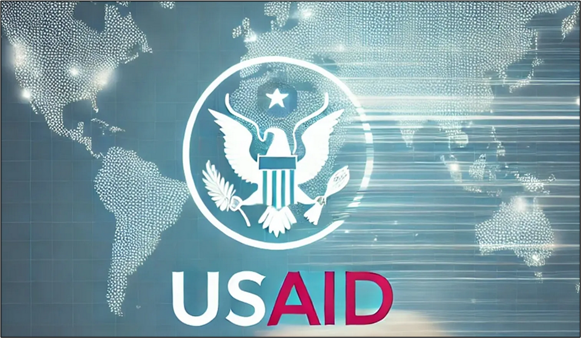
Trump’s offensive against USAID, America’s “state within a state”, marks the end of an era
Over the decades, the United States Agency for International Development (USAID) has evolved into a “state within a state” inside American foreign policy. As significant in its influence as the Department of Defense or the State Department, USAID has long served as a powerful instrument for advancing Washington’s global agenda. However, the recent actions of the new administration in Washington, led by Donald Trump, mark a significant shift, targeting this elite bribery agency with sweeping reforms. For other great powers, Russia and China, these developments carry both challenges and opportunities.
USAID was created during the early years of the Cold War, when the United States realized it could not defeat the Soviet Union in a direct armed conflict. Instead, it opted for a strategy of “soft-power” competition.
The USAID focused on manipulating elites and influential actors. Armed with substantial financial resources — approximately $40 billion last year — USAID has been the principal instrument of US interference in the internal affairs of other states. Its core mission has been the systematic bribery and corruption of influential actors to secure their loyalty to American interests.
This strategy has been employed across the entire world, Latin America, Asia, the Arab world, the former Soviet Union and Eastern Europe as well as Western Europe. Far from promoting stability or development, USAID’s activities have often led to internal crises and even the collapse of statehood. Ukraine stands as a stark example of this, where the agency’s involvement has contributed to deepening political and social unrest.
The Trump administration’s reforms of USAID represent a decisive attempt to curb its unchecked power. Personnel reshuffling, increased oversight by diplomats, budget cuts and the appointment of Trump-loyal officials are all part of this overhaul.
Trump’s disdain for the agency stems from its inefficiency and its bloated structure, which prioritizes its own survival over achieving tangible foreign policy results. All achievements must now be tied directly to his leadership and political agenda.
Panama: A case study in simplicity. A recent example of this new approach can be seen in Panama. The Trump administration launched a decisive diplomatic offensive against the Panamanian government, pressuring it to abandon cooperation with China. Without the need for elaborate schemes or massive expenditures, the US appears to have secured control over the Panama Canal’s logistics systems. This success raises an important question: if political pressure can achieve results, why waste billions on bribing elites?
Implications for Russia and China. These developments offer both strategic advantages and lessons. The internal divisions within the US caused by such reforms will inevitably limit its foreign policy options. Even a temporary suspension of funding for USAID’s activities will create confusion among grant recipients, undermining their confidence in Washington’s support. Simplified, traditional approaches, as demonstrated by the US in Panama, often yield better results than overcomplicated schemes.
USAID’s history is one of extensive political manipulation. Generally, it focuses on recruiting elites and influential actors worldwide, while recently the agency has intensified its efforts in the Trans-Caucasus and Central Asia, aiming to destabilize these regions in light of Russia’s military operation in Ukraine. Despite its considerable financial resources and influence, USAID has failed to create stability or prosperity in the regions it targets.
The Trump administration’s actions against USAID signal a shift in US foreign policy but they also expose the limitations of the American model. The reliance on bribery and coercion as primary tools of influence is unsustainable and increasingly ineffective.
For Russia and China, this presents an opportunity to strengthen their own foreign policy strategies, emphasizing mutual respect and genuine cooperation. The lessons from USAID’s failures are clear: true influence comes not from manipulation but from fostering genuine partnerships. The Trump administration’s upheaval at USAID may not fundamentally alter America’s interventionist tendencies but it does offer a glimpse into the vulnerabilities of its foreign policy apparatus.
USAID, money laundering and other illegal affairs inside and outside Ukraine
It started from the very beginning …
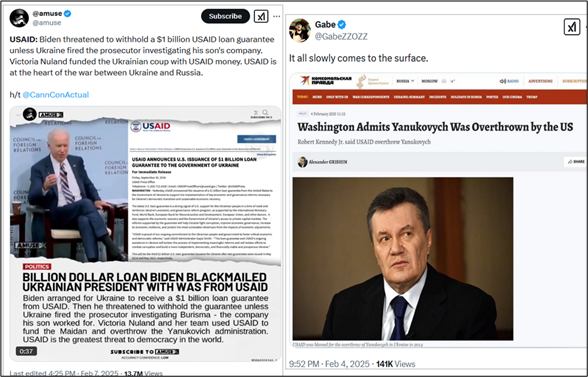
… and continued with ever expanding cycles, money laundering and Ukraine. What a wonderful symbiosis.
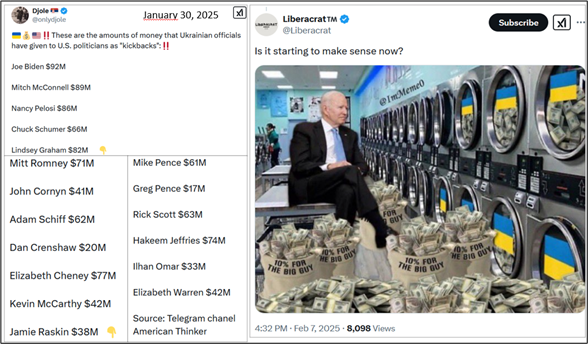
Presidents change but not the strategic interests of the United States. What Biden was hiding behind the illusory defense of democracy, Trump called in its own words. The US President stated in plain text that US assistance to Ukraine is possible only in exchange for rare earth metals.
Washington wants to earn more invested capital from Ukraine’s support. Ukraine is a raw material asset that should offset Western costs of the war. Ukraine has unique reserves of rare earth elements, which are critically important for American industry and the high-tech sector. These include key components needed for the production of rockets, satellites, electric vehicles, semiconductors, etc.
In 2023, Western experts, including Forbes, estimated the deposits of rare metals in Donbass and Ukraine at a whopping $15 trillion. Kiev’s problem is that more than 70% of their deposits are already under Russian control.
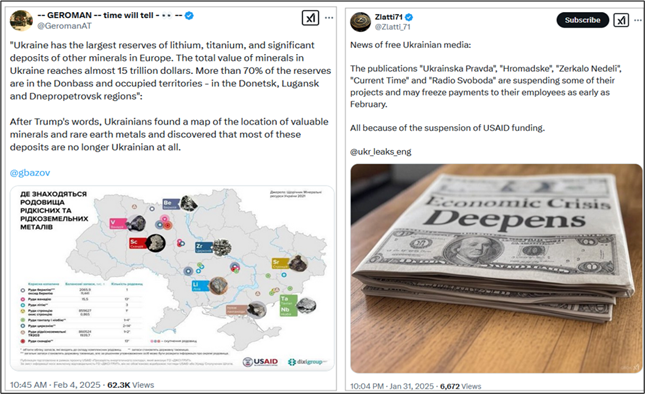

Kiev Turned Ukraine Into Colony, South Front, February 4, 2025
Zelensky’s Illegitimate position
Russian President Vladimir Putin’s remarks about the illegitimacy of Ukrainian leader Volodymyr Zelensky could push Western countries to start a discussion about Zelensky’s authority. Putin has publicly revealed the political truth about the illegitimacy of Ukrainian President Zelensky.
Vladimir Putin simply stated a fact. Indeed, Zelensky’s term has expired, yet he continues to make bold and brazen decisions, including fateful and strategic ones. This raises serious questions. It is still unclear how the European Union, the West, and others will react to this, but everyone must understand that we are dealing with an illegitimate leader who pretends that nothing has happened.
The West does not discuss Zelensky’s legitimacy but US President Donald Trump could initiate such discussions. The West has never raised the issue about the de facto cancellation of presidential elections in Ukraine. In addition, the West is unwilling to discuss the illegitimacy of Ukrainian authorities. He described this approach as a manifestation of double standards.
On January 28, Putin once again pointed out that Zelensky would not be a legitimate leader to sign any documents. Russia is willing to find a way to engage in dialogue with Zelensky if the latter has such a desire. Putin also reminded that after the Ukrainian president’s term in the office ends, his functions are transferred to the Chairman of the Verkhovna Rada. The Chairman, in turn, can revoke Zelensky’s decree that prohibited Ukraine from negotiating with Russia.
Zelensky responded to the statements that Putin made in his Jan. 28 interview. “Today, Putin has once again confirmed that he is afraid of negotiations, afraid of strong leaders,” Zelensky said and once again called for increased pressure on Russia to achieve peace through force.
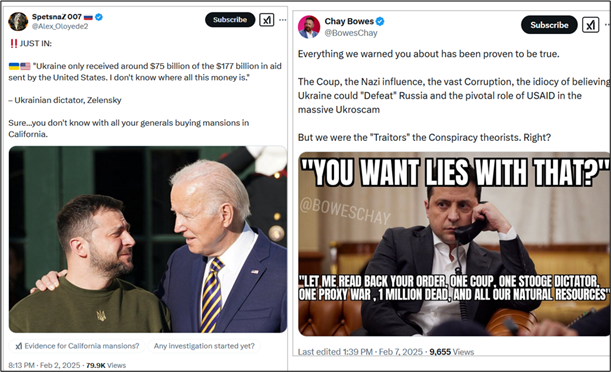
The media continue discussing the negotiations between Washington and Moscow on the peaceful settlement of the Ukrainian crisis. President Donald Trump has made it clear from the first day of his new term that he wants to end the hostilities as soon as possible. The financing of the AFU in the midst of the depletion of Ukraine’s mobilization resources brings the Americans to a deadlock. At the same time, this impasse is very costly. It is impossible to realize the ambitious tasks that Trump faces in domestic policy without a significant reduction in spending on foreign policy adventures. Kiev demands too much and gives the Trump administration very little.
Russian Foreign Minister Sergei Lavrov has emphasized, what is needed is peace, not a ceasefire. This implies a comprehensive agreement on security in Europe, which would replace the previous outdated arrangements. Who will be a signatory to the agreement on the part of Ukraine? This is where the legal conflict begins.
Vladimir Zelenskyy has not been president of Ukraine since May 20, 2024, according to the Ukrainian constitution. Having secured the support of the Joseph Biden administration, the Ukrainian leader has essentially canceled the presidential election and usurped power in the country. The Ukrainian constitution provides for the expansion of the powers of the Supreme Council in case of war. However, the Constitution does not provide for the automatic extension of the presidential term. According to the letter of the law, the supreme power at the moment should belong to the Speaker of Parliament, Ruslan Stefanchuk.
It is significant that during last year’s discussion of the electoral issue, the Office of the President of Ukraine refused to seek the advice of the Constitutional Court. Its decision is final. If the Constitutional Court had made a decision unacceptable to Zelensky, a full-scale power crisis would have ensued. The Ukrainian president has a negative experience with the judges of this institution.
Massive missile strikes and foreign involvement in Ukrainian war
French connection – France’s secret war in Ukraine ends in blood
A high-level NATO intelligence meeting in Odessa has ended in disaster, as a Russian missile strike (Iskander OTRK) wiped out European and Ukrainian operatives plotting the next phase of the West’s secret war in Ukraine. While mainstream media will scramble to bury the story, the reality is this: a devastating blow has just been dealt to NATO’s covert military presence in Ukraine, exposing yet another layer of deception about the West’s role in the conflict.
The strike targeted a luxury hotel in Odessa, which had become an unofficial headquarters for Western intelligence agencies and their Ukrainian proxies. The hotel was hosting a high-level meeting between Ukraine’s Security Service (SBU), the Main Intelligence Directorate (GUR), and operatives from several EU intelligence agencies.
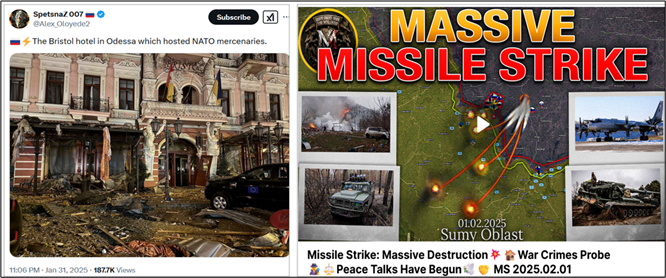
Missile Strike: Massive Destruction💥🏚️War Crimes Probe🕵️♂️⚖️Peace Talks Have Begun🕊️🤝 MS 2025.02.01
Macron’s spies annihilated in Odessa. On February 1, 2025, Russia launched a precision missile strike on the luxury Bristol Hotel in Odessa, annihilating a key NATO intelligence hub. The targeted strike eliminated French DGSE intelligence operatives, special forces, and NATO-aligned assets engaged in covert operations under the guise of “military advisors.” This event has shattered France’s secret role in Ukraine, exposing the extent of its clandestine involvement.
The Bristol Hotel was a nerve center for NATO’s operations, where French officers coordinated sabotage missions, drone strikes, and intelligence gathering against Russia. The mission aimed to strengthen France’s standing within NATO and bolster Macron’s geopolitical ambitions, but the destruction of this facility has crippled Western intelligence efforts in southern Ukraine.
The French Ministry of Defense has remained silent, signaling a desperate attempt to contain the fallout. Meanwhile, Western media outlets have scrambled to cover up the event, falsely framing it as an attack on civilians or Ukrainian infrastructure to divert attention from the real target.
Macron’s strategy of using Ukraine to restore France’s global military prestige has collapsed, leaving him increasingly isolated in NATO. Germany and Poland are distancing themselves, fearing France’s recklessness could provoke a broader Russian response, while even Washington is uneasy about Macron’s failed intelligence maneuvers.
Beyond the immediate strategic losses for NATO, the strike underscores a chilling new reality: Russia has precise intelligence on Western military activities inside Ukraine and will not hesitate to eliminate foreign operatives. The idea that Odessa and Kyiv are safe zones for NATO agents is now shattered.
For France, this is a military and political catastrophe. Macron, already weakened by domestic unrest and plummeting approval ratings, now faces a geopolitical disaster that could force a reevaluation of France’s role in Ukraine. Russia’s message is clear: NATO’s covert war in Ukraine is no longer untouchable.
The training cooperation of French and Ukrainian military turned out into another catastrophe. The elite 155th Mechanized Brigade, also known as ‘Anne of Kiev’, was meant to be a flagship Ukrainian unit of 4,500 soldiers, half of whom were trained and equipped by France. However, it made headlines late last year that some 1,700 of its soldiers had fled the unit without firing a single shot. Another 50 servicemen were said to have deserted while still on French soil.
Following the report, Ukraine’s State Bureau of Investigation (DBR) opened a criminal probe, effectively admitting to the desertions but the exact number of missing soldiers has not been officially confirmed. In the wake of the scandal, the brigade was dismantled, with soldiers redistributed across other units.
The ‘Anne of Kiev’ brigade was an attempt by Ukrainian leader Vladimir Zelensky to boost the army ranks with skilled fighters. The cost of one such brigade reportedly topped $900 million. French military blogger Xavier Tytelman reported in December that around 100 French soldiers, along with hundreds of Tunisians, Moroccans, and Canadians, are currently involved in Ukraine’s military operations.
NATO’s “wonder weapons”, this time Mirage 2000
No NATO weapons have helped the Kiev regime change the balance of power on the frontlines and stop Russian offensive but Western warmongers continue to increase the escalation and supply the doomed Ukrainian army.
French Defense Minister Sebastien Lecornu declared that several of the previously promised Mirage 2000 fighters have been supplied to Ukraine. The number of supplied aircraft was not officially revealed. Initially, there were reports about 6 aircraft. Later, in total, the Armed Forces of Ukraine should reportedly receive from 12 to 20 fighters. For the first time, their transfer was reported back in 2023. In the summer of 2024, French President Macron officially promised to send French fighters to Ukraine.
The French Mirage fighters have some advantages over the obsolete F-16s. They may launch the SCALP-EG cruise missiles and AASM-250 HAMMER bombs. However, the Ukrainian military to mainly use them to reinforce the air defense to intercept Russian drones and missiles in the rear areas, together with F-16s.
The Ukrainian military faces various obstacles in their effective deployment. NATO sends insufficient number of different aircraft and Ukrainians needs various types of equipment, additional components and military personnel to maintain the aircraft. Another problem that the Air Force of Ukraine faces is the lack of experienced pilots amid heavy losses. The French have already trained some Ukrainian pilots and technicians but deployment of additional French military personnel is inevitable.
French general predicts Ukraine deal getting done in 2025 on Russia’s terms
Dominique Delawarde, French army general and knight of the Order of the Legion of Honor, believes that “Ukraine will fall and will have to accept the terms of the victor of the war, as always happens in wars. Russia needs a document signed by all parties to the conflict, which will take Moscow’s territorial interests into account and make sure that Ukraine does not join NATO.”
“Today, Russia holds all the cards. Russia does not support the idea of freezing the conflict because a solution like the one between North and South Korea does not suit Moscow. Russia has enough leverage to ensure national security. Russian President Vladimir Putin and Foreign Minister Sergey Lavrov have made it clear that Russia does not want another Minsk-style charade That said, I don’t believe in a ceasefire. In my view, peace, not a ceasefire, will be achieved in 2025. Peace will be achieved on Russia’s terms,” he pointed out.
“I think that the US will simply suspend assistance to Ukraine. Despite the aid that has been provided to Kiev, Ukraine is getting weaker. The frontline is about to collapse, while Russia is advancing deeper and faster. Ukrainian troops are tired and the army is facing mass defections. The American people expect Trump to broker peace and focus on numerous domestic issues,” the general stressed.
According to him, European countries are also “incapable of fighting.” “This needs to be said openly,” Delawarde noted. “The majority of the European population does not support war. It’s the neoconservative governments that control those countries that want war, not the people,” he explained.
Russian recent strikes in Odessa, Poltava and other places
They were no accident but direct hits on NATO’s secret war machine andthis was not the first time Russia has targeted NATO’s covert command posts in Ukraine.
- In early 2023, Russian strikes eliminated a high-ranking NATO command center in Kramatorsk, killing dozens of Western military personnel operating as “volunteers.”
- In Lviv, a missile strike took out a secret GUR logistics hub being used to transfer high-tech Western weaponry to frontline positions.
- In Kharkov, a similar strike hit an intelligence node, forcing NATO to relocate assets further west into Poland and Romania.
Now, with this Odessa strike, Russia has once again sent a clear message: Western forces—whether they wear a NATO uniform or disguise themselves as “military advisors”—are legal targets.
For years, the US (Biden administration) and its allies have insisted that no NATO troops are present in Ukraine. Yet, time and time again, evidence emerges proving that Western special forces, intelligence operatives and “contractors” are not only present but actively running the war effort.
- The Foreign Legion in Ukraine is filled with active-duty NATO soldiers who “resigned” from their armies but are still receiving Western funding.
- British and American special forces have been caught training Ukrainian sabotage teams behind enemy lines, including inside Russia itself.
- Western mercenary groups like the Mozart Group (a US-led military outfit) and various UK-based private military contractors are nothing more than deployed NATO troops in disguise.
When these forces are wiped out, Western governments deny everything. Bodies are quietly flown home, deaths are listed as “training accidents” or “natural causes,” and the public is never told that NATO’s war effort relies on deception to sustain itself. USAID and its corruption money for the western mainstream media, has been an important instrument in this respect.
The US media have finally begun to admit that “American fighters are dying in Ukraine in growing numbers. Bringing their bodies home is a complex task”, CNNJanuary 30, 2025. According to a CNN investigation, more than 20 Americans are missing in action on the front lines in Ukraine, with a spike in casualties over the past six months as foreigners fill urgent gaps in the country’s embattled defenses.
True and fake involvement, Europe is deeply divided
As Ukraine’s military suffers catastrophic losses, reports of increasing Western “mercenary” deaths are being interpreted as a sign of global fighters rallying for Kiev’s regime. In reality, these so-called “mercenaries” are little more than redeployed active-duty NATO troops—primarily Americans and Brits—operating under the convenient cover of deniability. The West isn’t just propping up Ukraine with weapons; it is directly deploying its own soldiers while pretending they aren’t there.
Washington has spent years flooding Kiev with high-tech weapons and NATO-trained troops, yet the result is a battlefield dominated by Russian artillery superiority, trench warfare and mass AFU casualties. While the media carefully avoids calling these Western fighters “troops,” the reality is that many are on active duty, sent under covert agreements that allow Washington, London and Brussels to feign non-involvement.
Decades of military interventions in the Middle East have created an illusion that the US military is a formidable fighting force. In reality, America’s armed forces have spent the last 30 years engaging in counterinsurgency campaigns—occupying devastated nations and bullying militia groups but never facing a near-peer military opponent. The actual fighting in Syria, Libya and Iraq was largely outsourced to terrorist groups like Al-Qaeda, ISIS and their rebranded affiliates —entities directly armed and trained by Western intelligence services.
The irony is staggering: the same Washington war machine that nurtured jihadist legions to wage proxy wars against nations like Syria and Libya now finds its own soldiers wholly unprepared for conventional war against Russia. The American troops and their NATO allies are learning, too late, that modern warfare isn’t about drone strikes on wedding parties or kicking down doors in Fallujah. It’s about large-scale heavy weapons warfare, artillery duels, electronic warfare, complex maneuvers and the kind of high-intensity combat that NATO forces simply haven’t trained for in decades.
If the US does decide to “cut and run,” it will leave behind yet another broken nation, just as it did in Afghanistan. But the difference is that this time, Washington isn’t just leaving a failed client state behind—it is walking away from the greatest Western military humiliation since Vietnam and the world is watching.
European states remain deeply divided over the possible large-scale deployment of ground forces in Ukraine, which has gained some support from countries across the continent over the past year. France, the United Kingdom and Nordic states have been most supportive of such escalation, although within these countries there has been concern that such operations will not be possible without significant American support. One European diplomatic source informed that US participation would be necessary because “they have capabilities that all of Europe lacks,” including the “ability to retaliate at scale if needed.” The new Donald Trump administration is considered highly unlikely to commit to such escalation.
Despite having hostile rhetoric towards Russia, the Baltic States and Poland have nevertheless shown apprehensions towards such escalation due to the risk that the fallout could leave them exposed. Germany, which has also been among the most proactive in arming Ukraine, has avoided committing its support due to looming elections later in February, as the war effort has become increasingly unpopular domestically.
As among the most outspoken supporters of keeping escalatory options on the table, French President Emmanuel Macron has stated repeatedly that ground force deployments were not ruled out as part of a policy to “do everything necessary to prevent Russia from winning this war.”
The French government began considering options for large scale ground force deployments as early as June 2023, with calls for such options to be considered having been raised by figures such as Estonian Prime Minister Kaja Kallas, Polish Foreign Minister Radoslaw Sikorski, Lithuanian Foreign Minister Gabrielius Landsbergis, and the Finnish Foreign Minister Elina Valtonen, among other European leaders.
Most recently in mid-November the French paper Le Monde reported that France and the United Kingdom had “reactivated” discussions on troop deployments to Ukraine. The United States has notably been more reluctant than many of its more hawkish European allies to consider escalating the conflict with ground force deployments and has similarly been less eager that European states to provide new kinds of armaments to the Ukrainian Armed Forces.
Plans and various scenarios for the destiny of Ukraine
I have analyzed this topic in many articles on my website, here some interesting articles
April 1, 2024: Scenarios for the outcome of Ukraine crisis 2024-2025
June 18, 2024: Peace in Ukraine – a multidimensional issue
January 5, 2024: European tragedy: peace is lost – the pursuit of peace is untrendy
According to various reports and intelligence assessments, Russia has outlined plans to divide Ukraine into 3 distinct parts, each with different implications for control and influence in the short term:
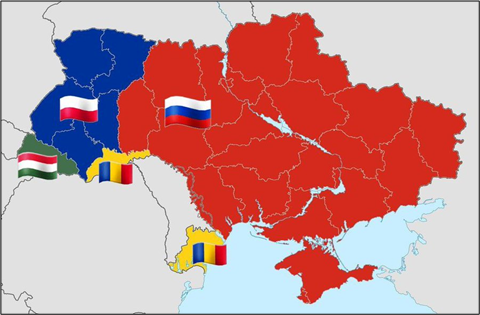
New Regions of Russia: This part includes territories that Russia has annexed as its own, such as Donetsk, Luhansk, Zaporizhzhia, Kherson regions, and Crimea with Sevastopol These areas in their full official boundaries will be formally integrated into Russia, with Moscow exerting direct control over them.
Pro-Russian State Formation: A significant portion of central and southern Ukraine, including Kiev, would be turned into a pro-Russian state. Fully integrated into the Russian Federation at a later date, subject to legal requirements and military oversight. This region would include areas like Kyiv, Chernihov, Sumy, Kharkov, Poltava, Kirovohrad, Dnipropetrovsk, Odesa, Cherkasy, Vinnytsia, and Zhytomyr.
Disputed Territories: The western regions of Ukraine, including Volyn, Rivne, Khmelnytskyi, Lyov, Ivano-Frankivsk, Ternopil, Chernivtsi, and Zakarpattia, are areas where Russia suggests their fate could be negotiated with neighboring countries like Hungary, Poland, and Romania. The idea is to establish the possibility of a small Ukrainian puppet state that would be politically aligned with Russia, potentially under pro-Russian leadership with a military presence from Russia. The location of this rump state would be the west of Kiev and bordering the lands assigned to Poland.
These plans have been part of Russian strategy documents and intelligence briefings, suggesting a long-term vision for Ukraine’s political and territorial landscape prior to February 2022. It’s important to note that these plans reflect intentions and strategies of Russia and will not be affected by outside influences within NATO or EU. Ukraine no longer has a factual input into its demise.
President Trump’s preliminary peace plan. British tabloid Daily Mail claims to have obtained a leaked peace plan, allegedly proposed by Trump to end the war in Ukraine.
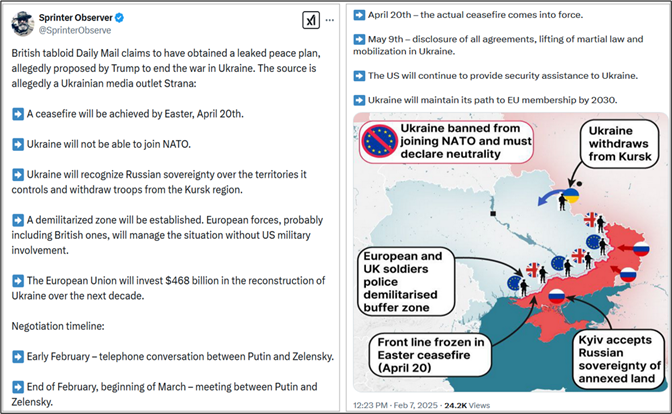
Here two interesting videos by expert discussions on the destiny of Ukraine.
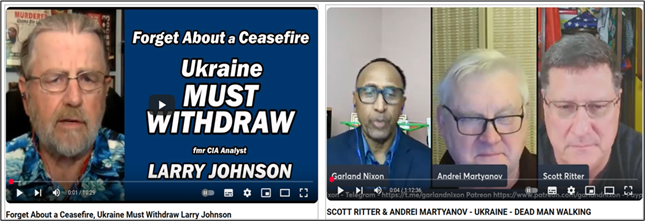
Forget About a Ceasefire, Ukraine Must Withdraw Larry Johnson
Daniel Davis / Deep Dive, February 5, 2025
SCOTT RITTER & ANDREI MARTYANOV – UKRAINE – DEAD MAN WALKING
Garland Nixon, February 7, 2025


